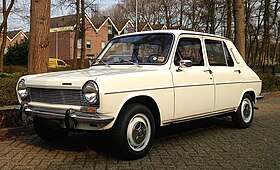
Back Simca 1100 AF Simca 1100 Catalan Simca 1100 Czech Simca 1100 German Simca 1100 Spanish Simca 1200 EU سیمکا ۱۱۰۰ FA Simca 1100 Finnish Simca 1100 French Simca 1100 GL
| Simca 1100 | |
|---|---|
 | |
| Overview | |
| Manufacturer | Simca |
| Also called |
|
| Production | 1967–1985 |
| Assembly | |
| Body and chassis | |
| Class | C-segment compact family car |
| Body style | 3/5-door hatchback 5-door estate 2-door coupe utility (pickup) 3-door van |
| Layout | Front engine, front-wheel drive |
| Related | Matra Rancho |
| Powertrain | |
| Engine |
|
| Dimensions | |
| Wheelbase | 2,520 mm (99.2 in) |
| Length | 3,937 mm (155.0 in) |
| Width | 1,587 mm (62.5 in) |
| Height | 1,460 mm (57.5 in) |
| Kerb weight | 918 kg (2,024 lb) |
| Chronology | |
| Successor | Talbot Horizon |
The Simca 1100 is a series of French compact family cars – mainly C-segment hatchbacks, but also a compact wagon and popular delivery vans – built for over 15 years by French car-maker Simca, from 1967 through 1982/1985. There was even a very early 'hot hatchback', and a family cross-over: the Matra Simca Rancho. The hatchbacks were replaced by the Simca-Talbot Horizon.
The 1967 Simca 1100 series is historically impressive for its very early combination of many modern design features – in very affordabe cars, and in many available (engine) configurations. The 1100 series were the first unibody family hatchbacks and compact estate car, to integrate a transversely mounted engine and front-wheel drive, with all-around, modern independent suspensions with anti-roll bars (double wishbones up front, and rear semi-trailing arms), and disc brakes, rack and pinion steering, and folding rear seats, for maximum space utilisation and practicality.
The 1967 introduced front-wheel drive Simca 1100 hatchback range was a top seller across Europe, and said to have (contributed to) convince Volkswagen to replace its entire, all rear-engined and -drive vehicle range, with a whole new, front-engined and front-drive range,[3] leading to the Mk 1 VW Polo, Golf and Passat series.[citation needed]
At just under four metres in length (3.94 m (12.9 ft)), the 1967 Simca 1100 series hatchbacks practically set the blueprint for European and Japanese C-Segment hatchbacks, defining most of their core design traits for several of the following decades.
- ^ 1977 Dodge 1100 Pickup (UK) advertisement, www.flickr.com Retrieved 3 August 2015
- ^ Thompson, Andy. "The Simca 1204 (US) and Simca 1100 - most popular car in France - and Talbot Wind". Allpar.com. Archived from the original on 15 December 2012.
- ^ The commonality between front-drive and -engine, and rear-drive and -engine, is to bring the power-source to the powered axle, at the same end of the vehicle. This brings the engine's weight over the driven wheels, improving traction; and cutting a drive-shaft running from front to back, saves weight and material costs, and avoids a tunnel, giving a flat, more spacious cabin floor. Mounting the engine transversely is also made easier, removing the typical gearbox hump between the driver and front passenger's legs, badly obstructing three-abreast seating room on the front row. However, an important difference is that supple front-wheel drive requires constant velocity joints, costly parts that carmakers mostly avoided, into the 1960s, and a big reason why so many affordable and economy cars were rear-engined after World War II.